Are you a turtle enthusiast? Do you live in Missouri? Well, it turns out you can find quite a few turtles in the wild in this state. Check anywhere with water and you are likely to spot one of these species of turtle. Just be sure to leave them be—while it’s legal to have these turtles as pets, you cannot capture them in the state of Missouri. You can, however, buy them at a pet store or online. If you’re into hunting turtles, it’s okay to hunt the softshell and snapping versions.
Let’s find out about a handful of turtles you can find in Missouri!

The 10 Turtles Found in Missouri
1. Eastern River Cooter
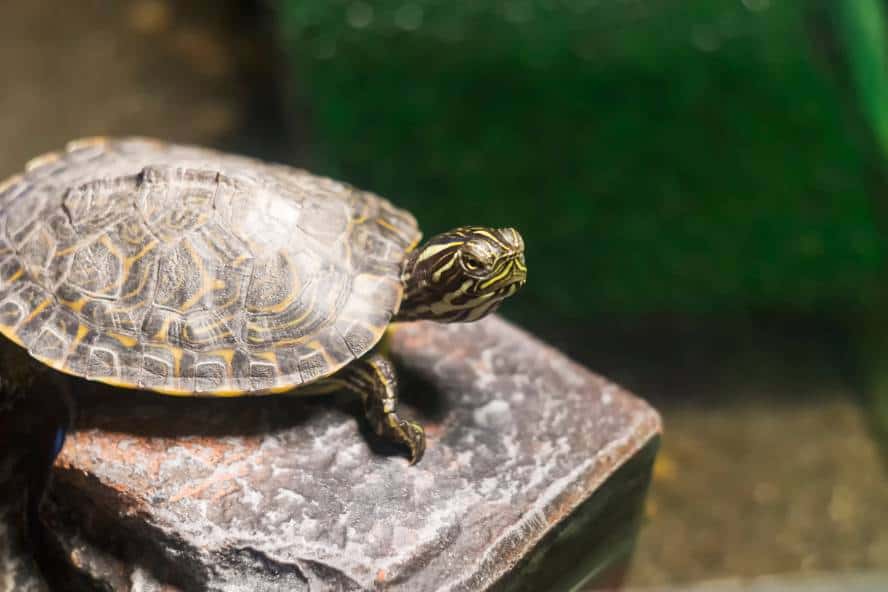
| Species: | Pseudemys concinna concinna |
| Longevity: | 20 – 40 years |
| Good to own as a pet?: | Yes |
| Legal to own?: | Yes |
| Adult size: | 8 – 12 inches |
| Diet: | Herbivore |
You can find eastern river cooters in the southern parts of Missouri, in or out of moving water such as streams and rivers. They are spotted by their domed shells, which come in brown, olive, and any color in-between, and by the yellow markings on their heads. These little guys are quick, so don’t expect to easily hold one if you have one as a pet. They love to sun themselves on rocks and logs, but they also can breathe underwater.
2. Common Map Turtle
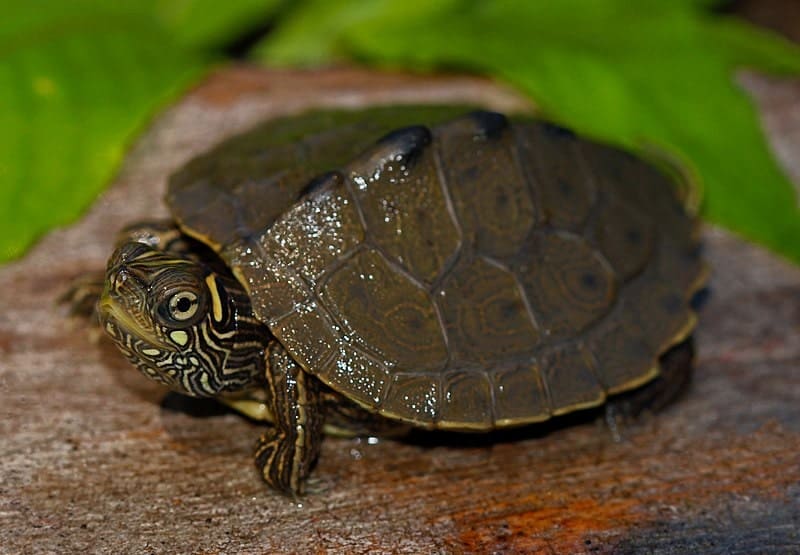
| Species: | Graptemys geographica |
| Longevity: | 15 – 20 years |
| Good to own as a pet?: | Yes |
| Legal to own?: | Yes |
| Adult size: | 4 – 10 inches |
| Diet: | Carnivorous |
Map turtles get their name from the map design on their backs. You can find this turtle mainly in the central region of Missouri, usually near the water. They have dark brown shells with yellow markings. Though they like to bask in the sun, they are superb swimmers and do not venture far from it. They like to eat fish, crayfish, and sometimes plants.
3. Blanding’s Turtle
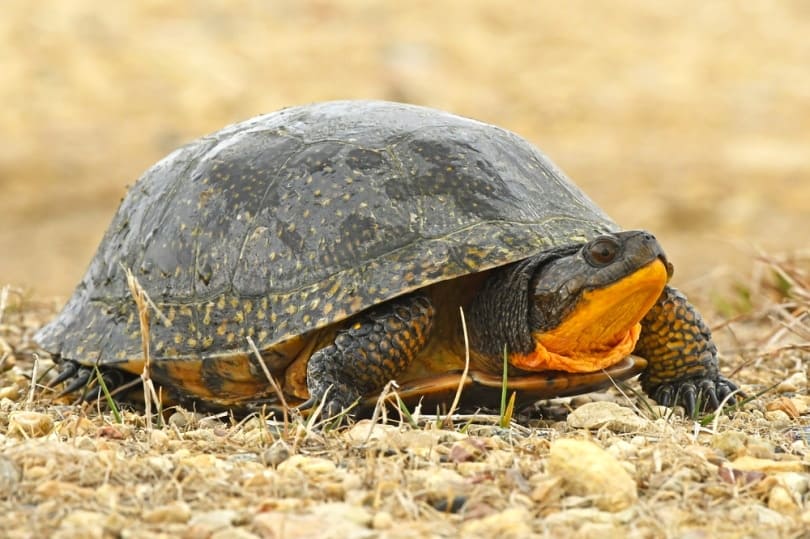
| Species: | Emydoidea blandingii |
| Longevity: | Up to 80 years |
| Good to own as a pet?: | Yes |
| Legal to own?: | Yes |
| Adult size: | 5 – 8 inches |
| Diet: | Omnivorous |
Blanding’s turtle, also known as the turtle that smiles, was named after William Blanding, the naturalist that discovered the turtle. You can find these dark-shelled turtles in the northernmost parts of Missouri. They are tough to spot, however, because they are an endangered turtle species. Plus, they are timid and will jump into the water at any sign of disturbance.
They eat crayfish, worms, and other water-born invertebrates without the help of water to swallow them down. They also occasionally eat plants.
4. Ouachita Map Turtle

| Species: | Graptemys ouachitensis |
| Longevity: | 15 – 20 years |
| Good to own as a pet?: | Yes |
| Legal to own?: | Yes |
| Adult size: | 3.5 – 10 inches |
| Diet: | Omnivorous |
Ouachita map turtles, like the common map turtle, live in central Missouri. They prefer the rivers leading to Lake Ozark. They do not stick around long; if they sense something close by, they will jump into the water to get away. Ouachita map turtles differ from other map turtles by the yellow spots on the sides of their heads. When it comes to food, this turtle prefers aquatic larvae, mollusks, and plants.
5. Common Musk Turtle
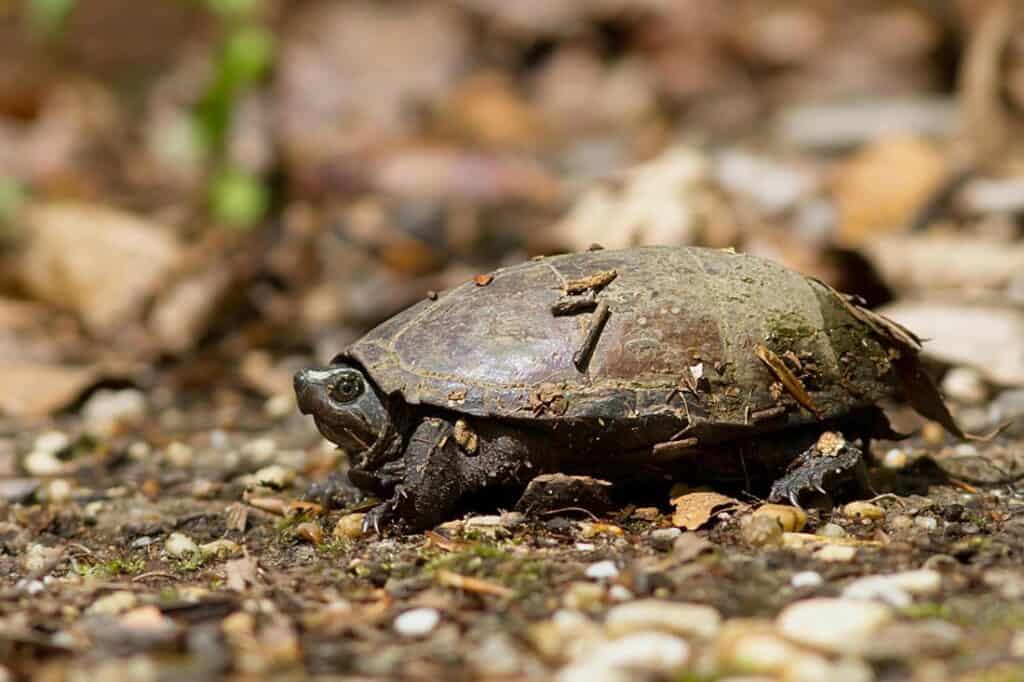
| Species: | Sternotherus odoratus |
| Longevity: | 50 years |
| Good to own as a pet?: | Yes |
| Legal to own?: | Yes |
| Adult size: | 4-5 inches |
| Diet: | Omnivorous |
This turtle gets its name from the powerful smell it can eject from its musk glands, giving it the alternative and endearing name, “stinkpot.” As Missouri’s smallest native turtle, you will be able to spot it by its dark shell with no markings in the southwestern part of the state. These turtles don’t swim very fast in their marshy habitats and prefer to eat crayfish, small fish, mollusks, and tadpoles.
6. Common Snapping Turtle
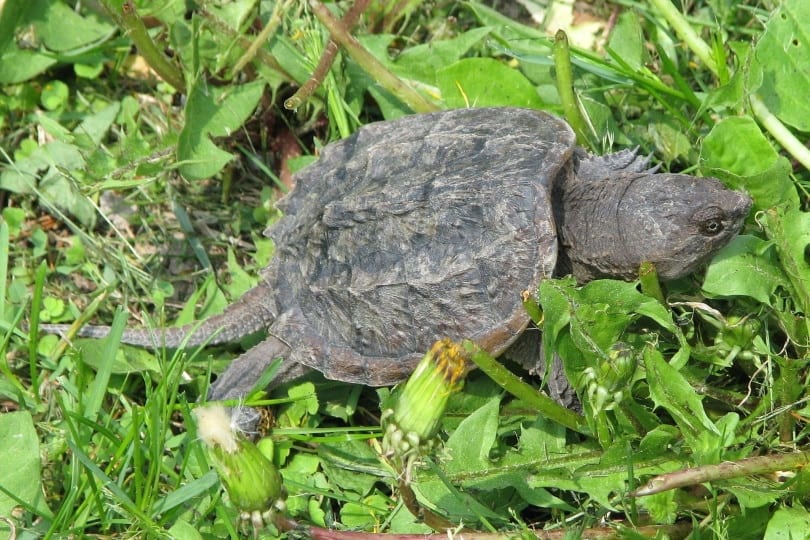
| Species: | Chelydra serpentina |
| Longevity: | 30 – 50 years |
| Good to own as a pet?: | Maybe |
| Legal to own?: | Everywhere but California |
| Adult size: | 18 – 20 inches |
| Diet: | Omnivorous |
Snapping turtles are found in all regions of Missouri, preferring large bodies of water. You will not see them out of the water often, as they mostly stick to staying in the water. They can be large, reaching almost 2 feet in length. You will know that you spotted one if you see its sharp “beak” on its mouth, dark shell, claws, and a long tail that has spines. This turtle has a pretty normal diet with this exception: it can catch waterfowl if given the right opportunity.
7. Ornate Box Turtle
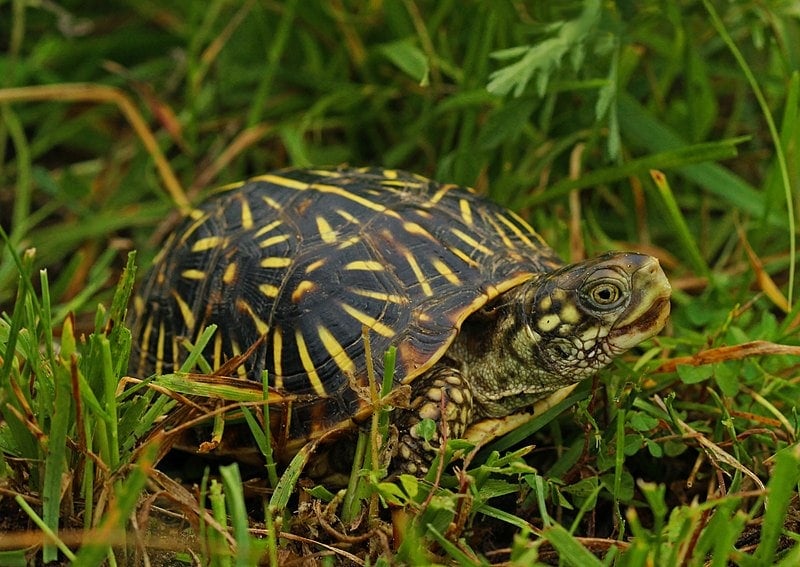
| Species: | Terrapine ornata |
| Longevity: | 28 years in captivity, 40 years in the wild |
| Good to own as a pet?: | Yes |
| Legal to own?: | Yes |
| Adult size: | 4 – 5 inches |
| Diet: | Carnivorous |
Ornate box turtles are common in Missouri but are especially common in the northern and western parts of the state. Much like their name suggests, these turtles have brilliantly patterned shells and skin that dazzle. These turtles are most active during the day in open and grassy plains, looking for food. Their preferred diet is earthworms and insects, but they sometimes eat cactus and other plants.
8. Midland Smooth Softshell Turtle
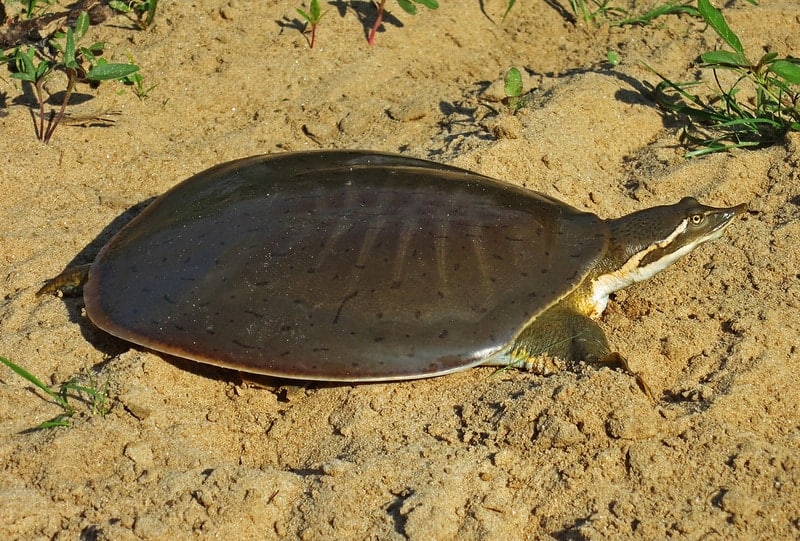
| Species: | Apalone mutica mutica |
| Longevity: | 25+ years |
| Good to own as a pet?: | No |
| Legal to own?: | Yes |
| Adult size: | 7 – 8 cm |
| Diet: | Carnivorous |
Midland smooth softshell turtles can be found on the sandy banks of many Missouri rivers. Unlike most turtles, the smooth softshell does not have a hard shell to protect itself. Rather, it buries itself in the sands along the riverside to hide from predators. You can see them active during the day, but at night they bury themselves to go to sleep. This turtle likes to eat insects, crayfish, and mollusks.
9. Red-Eared Slider
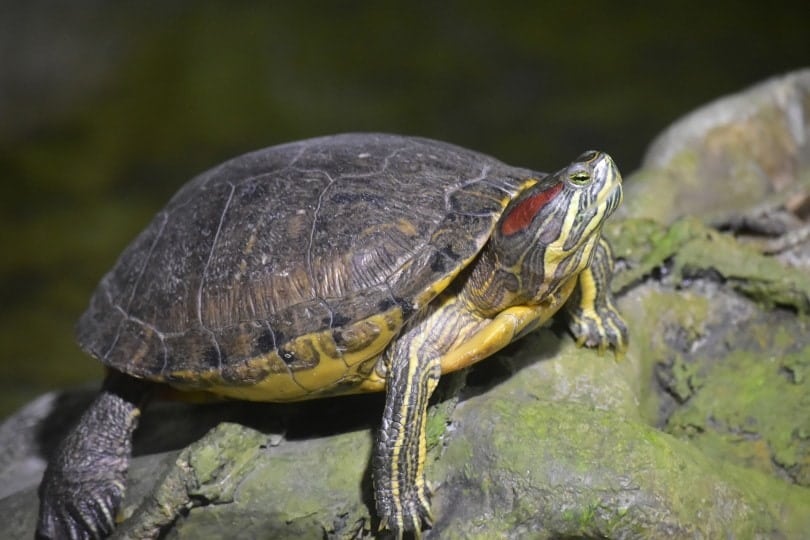
| Species: | Trachemys scripta elegans |
| Longevity: | 20 – 40 years |
| Good to own as a pet?: | Yes |
| Legal to own?: | Yes |
| Adult size: | 6 – 8 inches |
| Diet: | Omnivorous |
The red-eared slider is one of the most common turtles kept as pets. They can be recognized by the red markings on the sides of their heads. Another peculiar trait they have is stacking themselves on top of each other while they bask in the sun. You can find these turtles next to slow-moving water that is warm and in all regions of Missouri. Red-eared sliders love to eat small fish, underwater vegetation, and invertebrates like crayfish.
10. Western Chicken Turtle
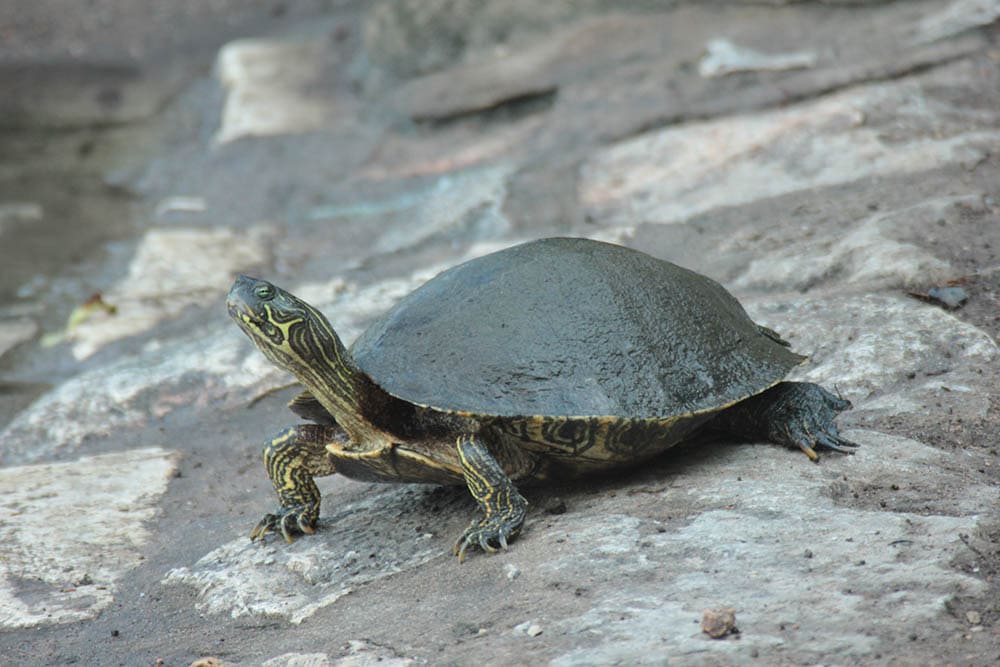
| Species: | Deirochelys reticularia miaria |
| Longevity: | 15 – 30 years |
| Good to own as a pet?: | Yes |
| Legal to own?: | Yes |
| Adult size: | 4 – 10 inches |
| Diet: | Omnivorous |
The western chicken turtle is one of three subspecies of chicken turtles. They get their name from the taste of their meat, which apparently tastes like chicken meat. They are characterized by their long necks and oval shells that are brown or olive with a net-like yellow pattern. You can find them in slow-moving water, with swamps being their preference. They are an endangered species in Missouri since swamps are slowly disappearing there.

Conclusion
Now you know many of the turtle species that live in Missouri. As you can see, there are many common turtles, like the common map turtle, and some rare ones, like the western chicken turtle. Remember that it’s illegal to capture any turtles to keep as pets in Missouri, however, you can hunt snapping turtles and softshell turtles with a fishing license.
Also See:
Featured Image Credit: Sergii Votit, Shutterstock
